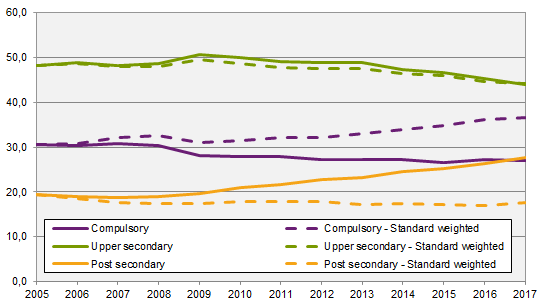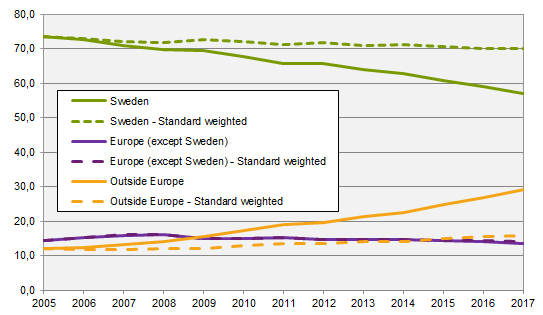The number of people who were involuntary out of work has dropped from 13.8 to 10.8 percent since 2005
Statistical news from Statistics Sweden 2018-05-31 9.30
In 2017, 620 000 people aged 20–64 were involuntarily out of work, of which 300 000 were unemployed and 320 000 were not in the labour force. This corresponds to 10.8 percent of the population, which was a reduction of 3.0 percentage points since 2005. The reduction in the number of people who were involuntarily out of work almost exclusively comprised people who were not in the labour force due to illness. The composition of the group changed in the period, chiefly with regard to educational level and birth region, which can largely be explained by demographic changes in the population as a whole.
The first thematic report in 2018 describes the group People aged 20–64 who were involuntarily out of work in the period 2005–2017. The group comprises all those who were unemployed and those who were not in the labour force due to illness or because they were admitted for care as well as people who considered themselves to be gainfully employed or looking for work but who were not classified as employed or unemployed according to the LFS.
Composition of the group
In 2005, 734 000 people aged 20–64 were involuntarily out of work. The corresponding number in 2017 was 620 000, of which 300 000 were unemployed and 320 000 were not in the labour force. Calculated as a proportion of the population, it corresponds to 13.8 and 10.8 percent, respectively, which is a decrease of 3.0 percentage points. The reduction in the number of people who were involuntarily out of work almost exclusively comprised people who were not in the labour force due to illness.
In 2017, 51.6 percent of those who were involuntarily out of work were women and 48.4 percent were men. Most of them, 46.6 percent, were 30–54 years old and the smallest group, 24.5 percent, were 20–29 years old. Of those who were involuntarily out of work in 2017, 44.0 percent had an upper secondary education, 27.7 percent had a post-secondary education and 27.1 percent had a compulsory education. The majority, 57.1 percent, were born in Sweden, while 13.7 percent were born in the rest of Europe and 29.2 percent were born outside Europe.
There were three major changes in the composition of those who were involuntarily out of work from 2005–2017. The first change was that the group was made up to a greater extent of young people and to a lesser extent of old people. The second change was that the group comprised more people with a post-secondary education and fewer people with other educational levels. The final change in the composition of the group was that the proportion of people born in Sweden fell over time while the number of people born outside Europe grew. The latter group more than doubled between 2005 and 2017.
The group’s composition after population adjustment
In the period from 2005–2017, there were demographic changes in the population aged 20–64. The proportion of people aged 20–29 increased while the proportion of people aged 55–64 declined over time. A greater proportion of people has attained a post-secondary education, while a smaller proportion of people have attained a compulsory education. A larger proportion was born outside Europe and a smaller proportion was born in Sweden. To see the effect of these demographic changes on the group of people involuntarily out of work, the composition of the population was kept constant for the entire time period, according to the composition in 2005 (by standard weighting).
When the composition of the population was kept constant, it became apparent that the trend in the composition of those who were involuntarily out of work was affected by the demographic changes. Two examples of changes involve the proportion with a post-secondary education and the proportion of people born outside Europe.
Without consideration for demographic changes related to educational level, the proportion of people who were involuntarily out of work and had a post-secondary education grew from 19.3 to 27.7 percent from 2005–2017. When the changed composition of the population was considered (by standard weighting), the proportion was 17.6 percent (Figure 1).

Source: Statistics Sweden, Labour Force Surveys (LFS)
Without consideration for demographic changes related to the region of birth, the proportion of people who were involuntarily out of work and were born outside Europe grew from 12.1 to 29.2 percent. When demographic changes were considered (by standard weighting), the proportion was 15.7 percent in 2017 (Figure 2).

Source: Statistics Sweden, Labour Force Surveys (LFS)
In other words, the changed educational level had a major impact on the composition of the group People who are involuntarily out of work by educational level. This also means the first impression – that people who were born outside Europe had more difficulties in the labour market than those from other regions of birth – was largely an effect of demographic changes. Sweden’s population aged 20–64 years merely comprised a greater proportion of people born outside Europe in 2017 than in 2005.
Time since the most recent employment
In 2005, 55.2 percent of those who were involuntarily out of work had been out of work for one year or more. The corresponding share in 2017 was 40.1 percent. In the same time period, the proportion of people who have never been employed doubled, from 11.7 to 24.3 percent. Those who worked in the last year made up 26.7 percent of the group in 2017, which is roughly at the same level as in 2005.
Publication
A more detailed account can be found in the report People aged 20–64 years who are involuntary out of work, 2005–2017.
Feel free to use the facts from this statistical news but remember to state Source: Statistics Sweden.
